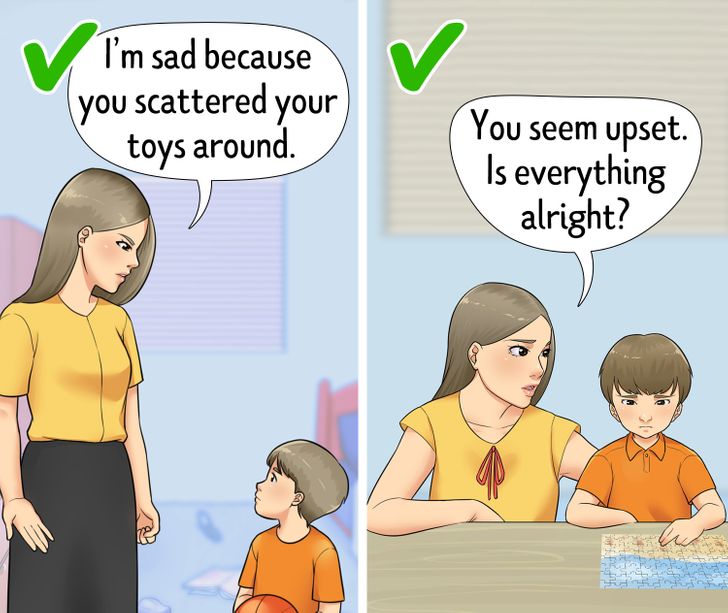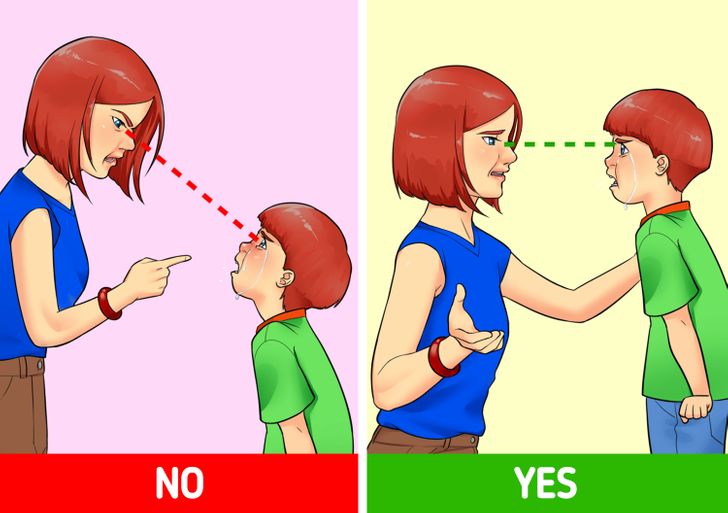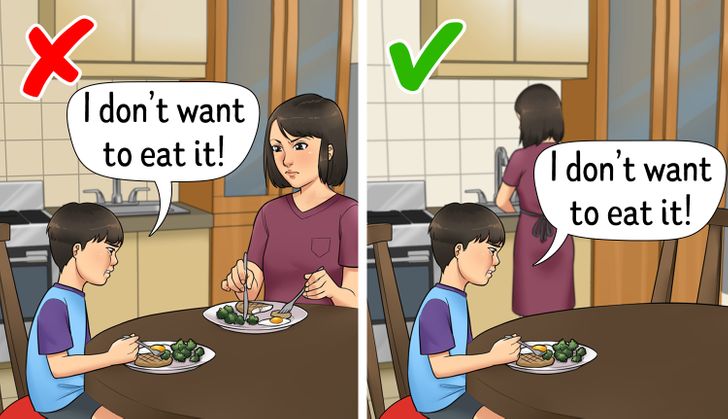8 Ways to Calm Down a Child

Some children, especially of a younger age, may have problems with regulating their emotions because they don’t know how to distinguish and control them yet. So tantrums, crying, and fighting with their peers can become a regular problem. While such behavior may be overwhelming for parents, there are ways to deal with children’s emotional outbreaks in a healthy way.
5-Minute Crafts came up with 8 basic techniques that will teach your child to cope with their emotions better and help you calm them down, even in the middle of a tantrum.
1. Teach the child to label their feelings.

Describing such an abstract concept as feelings may be difficult for a child. But kids rarely go from just being upset about something to throwing a tantrum. So the ability to spot these negative emotions helps keep them under control.
There are several ways parents can help their kids understand their emotions better:
- Describe your own feelings and explain why you’re feeling this way. It’s also a good idea to talk about the emotions of other people to teach your child empathy. For example, you can say, “I’m sad because you left your toys in your brother’s room. I guess he feels sad too because it’s a mess in there.”
- Rank the intensity of the emotions you’re having. If you notice that your child is sad, mad, or frustrated about something, ask them what they’re feeling and offer to describe the intensity of this feeling on a scale from 1 to 10 and explain what caused it.
- If you notice that certain actions or events usually stir certain emotions in your child, help your kid recognize them by giving a hint. For example, you can say, “It looks like collecting this puzzle irritates you,” or “You seem very happy that we went to see this film.”
2. Explain the difference between having feelings and acting on them.

Don’t ignore or try to minimize your child’s negative feelings and explain that it’s absolutely fine to feel anger, frustration, irritation, and sadness from time to time. But it’s essential to draw a line between having these feelings and acting on them.
For example, you can say, “I understand that you’re mad but it’s not okay to hit your brother if he refuses to share his toys with you.” And don’t forget to offer an alternative solution to the problem and say something like, “Don’t hit your brother. Just talk to him next time.” Your child should understand that violent behavior won’t be tolerated and there are other ways to resolve conflicts.
3. Give the child an opportunity to make a choice.

Children may throw a tantrum when they’re asked to do things that are unpleasant for them. But if you want to increase the chances of the child being more open to your requests, offer them alternative options they can choose from. For example, instead of saying, “We’re going to the mall after lunch,” you can suggest, “We can go to the mall together or you can spend time at your grandma’s while I’m there.”
Giving your child an opportunity to choose and allowing them to control the situation helps reduce tension and is likely to decrease the chance of an emotional outbreak. As a bonus, you’re less likely to spend a lot of time negotiating alternative options since you’ve already provided them.
4. Help your child to breathe.

When your child is going through intense emotions, slow breathing may help them relax and reverse the stress response. You can ask your kids to simply take several long and deep breaths, inhaling through their nose and exhaling through the mouth.
But if your child can’t concentrate, come up with a small game. For example, you can ask your child to imagine that their fingers are candles and suggest blowing them out, one by one.
5. Distract the child with a game.

First, do something unexpected, like turn off the lights or do some unusual gesture to grab your child’s attention. Then ask them to name 5 red objects in the room or touch 3 soft items. Your goal is to distract your child and switch their brain from emotional to logical.
Another trick that can help release negative emotions is to suggest that the child throw an imaginary angry ball. Your child should try to think about their emotions as a ball of energy. Then ask them to throw it as hard and as far as they can. This way, they’ll get rid of some anger and feel better.
6. Acknowledge the child’s emotions.

When your child is telling you about their negative emotions, show your kid that you’re truly listening to them and that you understand what they’re going through. Your goal is not to offer them a solution to the problem or to judge them but simply to be there for them. Don’t go with simple generic answers like, “Uh-huh,” or “Really?” Instead, try to come up with something more thoughtful.
For example, it might be a good idea to paraphrase the words of your child. For example, when the kid is complaining to you about all their math homework, you can reply by saying, “Wow, you have so many tasks to do today!” And you may want to support your child by saying, “You’re so good at math. I like how you always come up with a different approach to tackle all these math problems.”
When you talk to your child, make sure you’re on the same eye level as them. This way, you’ll help your child to feel more in control of the situation and they’ll see that you’re giving them your full attention.
7. Actively ignore negative behavior.

But keep in mind that acknowledging your child’s negative feelings doesn’t mean supporting and paying attention to their bad behavior. Your kid may misbehave when they crave your attention. And since they know you’re likely to react, your child may talk back, use inappropriate language, whine, or act too emotional on purpose.
If you notice that your child starts acting out, ignore their behavior for a while. For example, you can turn away and wait for such behavior to stop. But if your child does something you want to praise them for, pay attention to them immediately.
8. Prepare for the events that might trigger negative emotions.

If you know that your child is likely to go through some events that might be unpleasant for them or trigger strong emotional outbursts, help them to prepare for such an experience in advance. For example, if you know that your child is afraid to go to the doctor, tell them about the medical checkup you scheduled in advance.
You can recall the last time you were at the doctor’s office together and what emotions this experience caused. Discuss what could possibly make this experience more pleasant for your child and how you can help them handle these feelings. This way, you can come up with a plan to turn a negative situation into a more positive one.